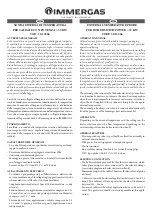
31
INSTALLATION
2.14
Electrical connections
The thermal module
Condexa PRO
is manufactured fully wired
and only needs to be connected to the mains, the room/heat
demand thermostat and any other system components.
9
The following is mandatory:
− The use of an omnipolar magnetothermic switch, line
disconnecting switch in compliance with CEI-EN stand-
ards (contact opening of at least 3 mm)
− Respect the connection L (line) - N (neutral). Keep the
earth conductor 2 cm longer than the power supply con-
ductors
− Use cables with a section greater than or equal to 1.5
mm
2
, complete with cable terminal caps
− Refer to the wiring diagrams in this manual for all electric
operations.
9
The use of adaptors, multiple sockets and extensions to
power the appliance is not allowed
9
to connect external electric components, it is necessary to
use auxiliary relays and/or contactors to be fitted in a dedi-
cated external electrical panel
9
Any work on the electrical system must be carried out only
by qualified personnel in compliance with all legal provi-
sion and safety regulations in particular
9
Secure the cables into the dedicated cable ties in order to
always guarantee their correct positioning within the ap-
pliance.
9
Electrical supply cables and control cables (room/heat de-
mand thermostat, external temperature probes, etc.) must
be strictly separate the one from the other and fitting inside
independent ribbed PVC sheaths up to the electrical panel.
9
The connection to the electrical power supply must be per-
formed using type 1 sheathed cables (3 x 1,5) N1VVK or equiv-
alent, while simple N07VK type or equivalent conductors can
be used for the thermoregulation and low voltage circuits.
9
If the electrical power provided by the electrical company is
of "
PHASE-PHASE
" connection type, preventively contact the
nearest Technical Assistance Service.
9
Never shut the appliance off during normal operation (with
the burner on) by shutting off the electrical power supply
using the On-Off key or an external switch. This could cause
the primary heat exchanger to overheat.
9
To switch it off (during the heating stage) use a room/heat
demand thermostat. The On-Off key can only be actioned
whist the appliance is in stand-by or emergency mode.
9
Before connecting any external electrical components to the
appliance (regulators, electric valves, climate control probes,
etc.), check to make sure that their electrical characteristics
are compatible with the available inputs and outputs (volt-
age, absorption, acceleration current).
9
Temperature probes must be NTC like. For resistance value,
refer to table pag 13
9
Always check the proper operation of the "grounding con-
ductor" for the electrical system to which the appliance will
be connected.
9
R
shall bear no responsibility for any personal injuries
or property damage caused by non-compliance with wiring
diagrams or the electrical system's incorrect/lacking con-
nection to the grounding system, or by non-compliance
with applicable CEI Standards.
0
It is strictly forbidden to use pipes of any kind to ground the
appliance.
0
It is prohibited to lay power supply and room/heat demand
thermostat cables near hot surfaces (delivery pipes). If they
may come into contact with parts that have a temperature
of over 50°C, use a suitable type of cable.
0
It is prohibited to touch electric appliances with damp/wet
body parts or when your feet are wet.
0
It is prohibited to leave the appliance exposed to weather
elements (rain, sun, wind, etc.) unless it is equipped with
the relevant weatherproof kit.
0
It is prohibited to pull, detach, or twist any electric cables
coming from the thermal module even when the latter is
disconnected from the mains power supply.
Proceed as follows to access the control panel terminals:
− Remove the locking screws and the panel's front side
− Pull and slide the electrical panel's box towards the out-
side (1)
1
1
















































